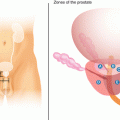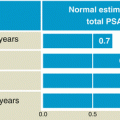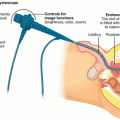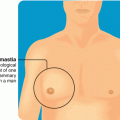Figure 5.1
Prostatitis
Type I Prostatitis
In general, this is an infection of the prostate appearing suddenly, that is, in an acute manner, caused by bacteria present in the urine. The patient may have burning pain while urinating, an increase in the frequency of urination, fever, pelvic pain, or urinary retention.
Sometimes the difficulty in urinating may be so severe that it is necessary to insert a catheter by way of the urethra up into the bladder in order to drain the urine. In those cases where it is not possible to introduce the catheter through the urethra, it may be necessary to place it through a small opening in the abdominal wall, a procedure called cystostomy. The treatment requires hospitalization and the administration of antibiotics, either intravenous or intramuscular. Once the fever recedes, the treatment should continue 4–6 weeks with oral antibiotics.
Although this type of prostatitis often occurs spontaneously, the probability of it appearing due to certain urological procedures is also known, such as the insertion of a catheter or carrying out diagnostic tests such as cystoscopies or prostate biopsies. It is often seen in men with conditions that predispose them to this problem, such as diabetes or narrowness of the urethra.
The infection can be recurrent since the bacteria are retained in the prostate despite treatment. Repeated episodes are more common if antibiotics are taken for less than 4 weeks or if the patient is suffering from other diseases of the urinary tract.
If recovery is delayed or if the fever returns or persists, other studies should be performed, such as a trans-rectal ultrasound or a CT scan, to evaluate the pelvis and determine whether other complications, such as a prostate abscess, exist.
In some cases, prolonged treatments with antibiotics and/or surgery to drain the abscess are required. In other situations a transurethral resection of the prostate may be required, similar to that done in cases of benign prostatic hyperplasia.
Type II Prostatitis
This refers to a long-standing (i.e., chronic) prostate infection. It can be the consequence of acute prostatitis, generally seen in older patients and commonly caused by the same bacteria. In general, this infection only makes itself known when it causes problems in urinating. The diagnosis is confirmed by the symptoms described above and a urine culture, which shows the presence of the microorganism causing the infection. For this, urine samples must be taken before and after a prostate massage, that is, after performing a digital rectal examination and gently massaging the gland. The samples are incubated in the laboratory to compare the growth of the bacteria. If the concentration of the microorganism is higher in the urine obtained after prostate massage, the conclusion is that the prostate harbored the bacteria and is the cause of the urinary tract infection. If the infections are very frequent or very severe, a long-term treatment with a low dose of antibiotic daily and indefinitely should be considered. It is important to rule out calculi (stones) or problems such as urinary retention or narrowing of the urethra, which predispose patients to these infections.
Type III Prostatitis
This type of prostatitis is also chronic, but it is not related to a bacterial infection. It could be described as chronic pelvic pain. This category represents more than 90 % of the cases diagnosed as prostatitis.
The majority of the patients are younger than 50 years old and suffer from symptoms such as pain in genitals, pelvis, or perineum; discomfort while urinating; and, sometimes, sexual dysfunction, including pain after ejaculation. In many cases the patient feels a great anxiety caused by this discomfort.
Lack of strength of the pelvic muscles is the cause of the pain, which sometimes is described as a stabbing or burning pain in places like the scrotum, anus, or groin. These problems are analyzed by means of a detailed examination of the abdomen, genitals, and pelvic muscles, which are palpable in an anorectal evaluation.
For some men the pain is not located in the area of the prostate but in more distant places, generally in muscles contracted in the back or inside the pelvis, but which are in relation to the nerves close to the prostate area.
These muscles are more vulnerable to the development of what is known as trigger points, that is, specific points which when stimulated provoke the pain, which is exacerbated in people who remain seated for a long time. Posture and repeated trauma perpetuate the discomfort of the muscle and its irritability.
Stay updated, free articles. Join our Telegram channel

Full access? Get Clinical Tree








